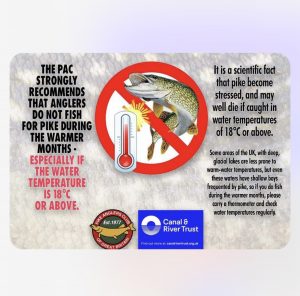The PAC Warm Water Piking Guide is available as a PDF file here:
The report “Guidance on optimal temperature regimes for protecting pike in catch and release activities” can be found here:
Warm Water Piking
The subject of fishing for pike in warm water conditions is a highly emotive one, and there is a lot of information – and disinformation – on this subject. Sadly, the scientific data is often misused to back up an individual’s point of view, usually arguing that it is fine to fish for pike in summer. It is a fact that pike can survive naturally in water with low oxygen levels – however, it is also a fact that pike are very poor at oxygen recovery following extended levels of exertion, i.e., from being caught on rod and line, and when they are returned to oxygen-poor water they can die. Pike are also quite fragile creatures, and extended handling and time out of the water can make this situation worse. The Pike Anglers’ Club recommends that anglers do not fish for pike if the water temperature is 18 degrees centigrade or above.
It is a scientific fact that pike become stressed and may well die in water temperatures of 18 degrees centigrade or above. The scientific report “Guidance on optimal temperature regimes for protecting pike in catch and release activities” can be found HERE on our website, www.pacgb.com, along with other relevant information.
The Pike Anglers’ Club has members all around the UK, and we recognise that they fish a variety of waters, from deep glacial lakes and fast-flowing rivers to shallow drains, canals and broads. In summer, these differing waters will hold vastly different amounts of dissolved oxygen. Colder water has a higher capacity for holding dissolved oxygen than warm water does; this is also a fact, which is why the PAC has never called for a blanket ban on pike fishing in the summer, as each water must be taken as an individual case. So, if you are considering fishing for pike warm water conditions, we would suggest the following guidelines:
Firstly, do you really need to target pike at all? There are many other species that offer great sport in the summer, and fare far better in warm water than pike. Even if you are purely a predator angler, then perch, zander, catfish and eels are all options open to you. Also, chub will readily take lures in the summer months.
Wherever possible, unhook the fish in the net in the water. Make sure that the fish is fully recovered and release it. Prolonged time out of the water, especially in warm weather, really is the killer for pike. Always carry a good set of cutters, so that, if needed, hooks can be cut rather than struggling to unhook a fish.
In warm water, pike will swallow baits a lot faster than in winter, avoid bait fishing wherever possible. This can lead to deep-hooking and prolonged time out of the water. Lures are generally far easier to remove than a deep-hooked bait treble. Also, as the strike is much more instant, there is far less chance of deep hooking with lures anyway.
Never retain pike in retainers or tubes, etc., in warm water. Ensure that the fish is fully recovered in your landing net, holding it upright, and return it once it’s ready to go back.
Consider when you go fishing. People often think the best time to go is at dawn, as it is cool then. However, this can be when dissolved oxygen levels are at their lowest. Plants produce oxygen as a by-product of photosynthesis during the day, while at night they absorb oxygen through respiration – so during the night they are removing oxygen from the water. Just because the cooler water at dawn has the potential to hold more oxygen, it doesn’t mean that it will. This is clearly evidenced by the fact that commercial fisheries will run their aerators through the night to maintain oxygen levels.
Never fish for pike during or just after heavy algae blooms. These can be common during the warmer months, and whilst algae are a net producer of oxygen, most of this is released into the atmosphere rather than being dissolved into the water. Thick algae blooms also reduce sunlight penetration into the water, and reduce the photosynthesis of plant life, which then reduces the oxygen levels in the water. When the algae blooms die off, they are consumed by bacteria in the water – this process consumes large amounts of oxygen and can lead to a huge crash.

